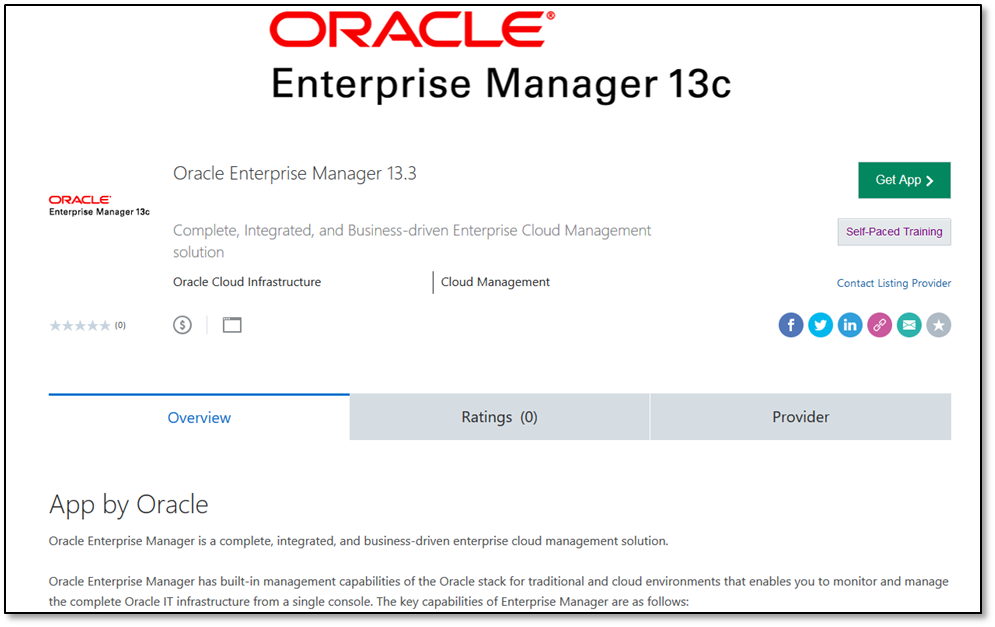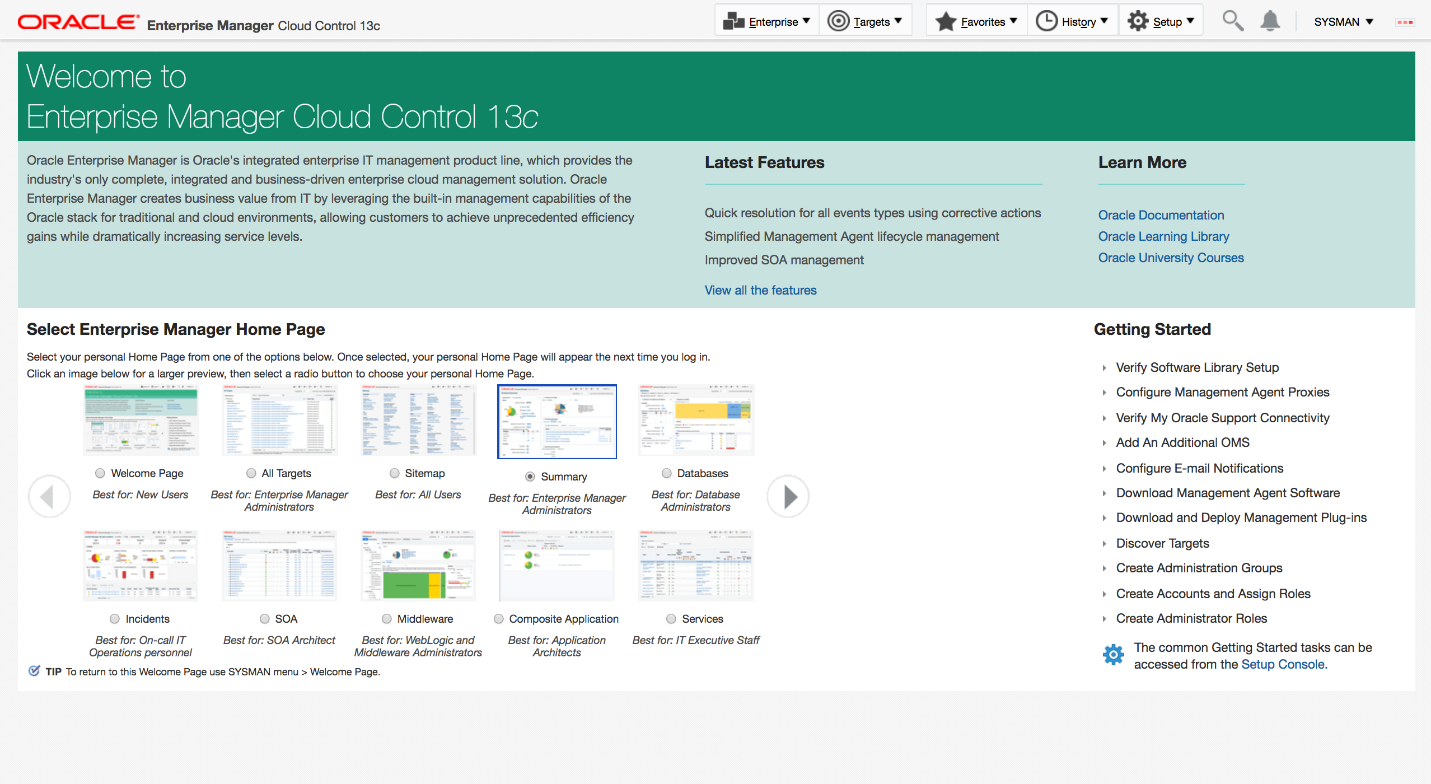Oracle Enterprise Manager is now available as an app on Oracle Cloud Marketplace! Here’s how to get started…
We’re excited to share that Oracle Enterprise Manager (EM) 13c is now available as an app on Oracle Cloud Marketplace. That means customers who are interested in trying EM without having to provision on-premises hardware have an easy path to start working with a fully-configured, updated EM instance with minimal installation effort.
Why is this important?
As regular readers of this blog know, Oracle Enterprise Manager has provided application-to-disk management for the Oracle stack and especially Oracle Database environments for many years. Over the years, customers have repeatedly asked us for simple ways to try out the latest-and-greatest EM environments without starting a large IT project on-premises. This app will provide a simple, easy-to-use “test drive” environment at your fingertips!
What’s in the Oracle Enterprise Manager app on Oracle Cloud Marketplace?
The EM app (available HERE, pictured below) consists of a pre-configured, ready-to-use EM 13.3 environment, including the Oracle Management Service (OMS) server and Oracle Management Repository (OMR) database for deployment on a single Oracle Linux host.
This app will install a brand-new EM instance which can be used immediately. It is NOT intended for migrations of existing (on-premises) EM environments.

This app deploys EM on a single host that has both the OMS and OMR. We made this single-host configuration available first because we know from experience that some customers use single-host configurations — plus, by experimenting with this app, you’ll be able to get used to the process of deploying and using EM in OCI! That being said, it’s important to remember that a single host can become a single point-of-failure, so you should make sure you consider your EM availability and performance needs if you intend to use this for production.
In the future, we’ll provide guidance on how to deploy more advanced EM configurations such as multi-host single instance, multi-host/multi-OMS with server load balancers, and multi-host/multi-OMR with RAC Database for High Availability (HA) and Maximum Availability Architecture (MAA) EM setups.
What IaaS Compute Options are most appropriate for this EM app?
In Oracle Cloud Infrastructure terminology, an “IaaS Compute Option” is a template that determines the number of CPUs, amount of memory, and other resources allocated to a newly created instance. Different options carry a different cost depending on their configuration. The EM configuration that is included in the Marketplace app is optimized for a ‘Medium’ deployment size (100-1000 agents, 1000-10,000 targets). The most relevant IaaS Compute Options for the ‘Medium’ config are listed in the below table. While there are other smaller Compute Options (good for eval/Dev/Test) and even some larger Compute Options available, we recommend you select one of the two preferred options below when you proceed with your launch instance.
| Size | Agent count | Target Count | OCI Compute Option | OCPU | RAM (GB) |
| Medium | >= 100, < 1000 | >= 1000, < 10,000 | VM.Standard2.16 VM.DenseIO2.16 |
16 | 240 |
OK, I’m ready! How do I deploy the Enterprise Manager app on Oracle Cloud?
It takes about 60 minutes of elapsed time (with about 15 minutes of active work) to deploy the Enterprise Manager app, divided into 2 steps. The steps are contained in the User Guide, and we’ve also summarized them for you.
When you’re ready to deploy the Enterprise Manager app, read and follow the steps in these two blog posts IN SEQUENCE.
- PHASE 1 of 2: “EM App OCI Environment Prerequisites…You Must Do These Things Before Installing the EM App!” (5-10 minutes elapsed time)
There is some prerequisite preparation of your OCI environment that is required, and the prerequisite steps require that you (or whoever does the work) are an OCI Administrator for your organization. If you do not have those privileges, you’ll need to find out who in your organization can do the prerequisite steps for you. These are prerequisites, so DO NOT SKIP THESE STEPS OR YOUR PHASE 2 EM INSTALLATION WILL FAIL.
- PHASE 2 of 2: Installing the EM app into your new OCI Compartment (45-50 minutes elapsed time)
Once you (or you newly-befriended OCI Administrator) have performed the prerequisite steps (did I mention there are prerequisite steps?), you will need the OCI Administrator to give you the name of the (properly-configured) OCI Compartment into which you should be installing your EM app. You’ll then be able to proceed with the installation of the EM app.
What’s next after your EM app deployment is complete?
In upcoming blog posts, we’ll discuss how to get started with monitoring and managing targets, agent installation and agent lifecycle best practices for OCI-hosted Oracle Enterprise Manager instances. You can also attend these free upcoming webinars to learn how to use your EM against specific targets such as Database, Exadata and others.
Two last reminders: Once your EM is installed and running, ongoing lifecycle management/maintenance/patching/upgrade of your Enterprise Manager is your responsibility, just as if you had installed it on-premises. Refer to the Cloud Control Upgrade Guide and Cloud Control Administrator’s Guide for best practices in these areas.
Similarly, if you are planning on using some of the larger OCI IaaS Compute Options, some configuration of the OMS and OMR may be required for your EM to fully take advantage of the increased CPU and Memory footprint…also just as if you had installed it on-premises. Refer to the Cloud Control Advanced Installation and Configuration Guide for more details.
How did it go?
If you’ve gone through the experience, we’d like to hear from you. How did it go? Suggestions for things we can make simpler? Are you using it for dev/test, production or both? What are you monitoring? Join the conversation in the Oracle Enterprise Manager Forum.
Finally, here’s the link to the Oracle Cloud Marketplace again. Good luck and keep us posted on your progress.
Enjoy your new Oracle Enterprise Manager instance!

Image 2: Enjoy your new Oracle Enterprise Manager instance!
